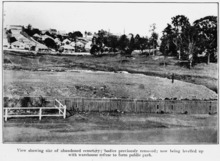North Brisbane Burial Ground

The North Brisbane Burial Ground was a former cemetery in the Town of Brisbane, Queensland, Australia. It was in the area now known as the suburbs of Milton and Paddington. It was also known as North Brisbane Cemetery, Paddington Cemetery and Milton Cemetery.
Geography
[edit]
The burial ground was located across four blocks bounded by Beatrice Street on the north, Hale Street on the east, Church Street on the south and the present-day Castlemain Street on the west. This land is now used as Lang Park stadium and Ithaca Swimming Pool and children's parkland (see plans).[1]
History
[edit]
now underneath Lang Park
The First Brisbane Burial Ground was established in 1825 when Brisbane was established as the Moreton Bay penal colony at present-day Skew Street (near the William Jolly Bridge northern endpoint). It was in use until 1843 when the North Brisbane Burial Ground opened.[2]
The North Brisbane burial ground was in use from 1843 to 1875, during which time up to 10,000 people may have been buried there.[3] After 1875, the burial ground was closed and new burials were to take place in the newly established Toowong Cemetery.
Circa 1862 the Anglican Church established a mortuary chapel for the cemetery. The mortuary chapel was demolished in 1891.[4]
The cemetery was flooded during the 1893 Brisbane flood.[5]

In 1907, the Ithaca Shire Council began to plan to convert the cemetery, by then an eyesore for the community, into a recreational reserve. However, the council did not control the land, as individual religious denominations continued to have control of their respective burial grounds.[6] By the 1910s, relatives were offered the opportunity to exhume and reinter deceased family members or to relocate their headstone or other monumental masonry. The first removals took place in 1913.[7] Over 500 headstones were removed into a memorial reserve, a small section of the Anglican section of the cemetery, adjacent to Christ Church. In 1914, it was developed as an athletics field called Lang Park and progressively redeveloped into Brisbane's major sporting stadium, Suncorp Stadium.[8]
During the Depression many of the headstones in the memorial reserve were removed or destroyed.[8] In 2001, the development of Hale Street into a major traffic route resulted in the resumption of some of the memorial reserve and the remaining headstones were reorganised into an even smaller memorial park behind Christ Church (and are only accessible via the churchyard). The further development of Suncorp Stadium visually encroaches on the memorial park, its high blue glass walls reflecting blue light into the memorial reserve.[8]
Operation
[edit]The North Brisbane burial ground was not a single cemetery, but rather a collection of cemeteries operated by different religious denominations.
References
[edit]- ^ "Showing the Old Paddington Cemeteries and the Present Reserves" (PDF). Brisbane City Council. Archived (PDF) from the original on 23 September 2015. Retrieved 10 March 2015.
- ^ "First Brisbane Burial Ground (entry 700009)". Queensland Heritage Register. Queensland Heritage Council. Retrieved 1 August 2014.
- ^ "Dr Jonathan Prangnell". University of Queensland. Archived from the original on 22 March 2015. Retrieved 10 March 2015.
- ^ "Closed Anglican Churches". Anglican Church South Queensland. Archived from the original on 3 April 2019. Retrieved 29 June 2020.
- ^ "Flood map Suburbs of Brisbane sheets 1 and 1W left bank" (Map). Queensland Government. 1893. Archived from the original on 28 June 2020. Retrieved 28 June 2020.
- ^ "Ithaca Town Council". The Brisbane Courier. National Library of Australia. 29 October 1907. p. 6. Archived from the original on 3 September 2023. Retrieved 11 March 2015.
- ^ "Paddington Cemetery". The Brisbane Courier. National Library of Australia. 7 June 1913. p. 4. Archived from the original on 3 September 2023. Retrieved 11 March 2015.
- ^ a b c "Christ Church (entry 600252)". Queensland Heritage Register. Queensland Heritage Council. Retrieved 1 August 2014.
Further reading
[edit]- McGowan, Glenys (2007), Deterioration of Human Remains and Artefacts in the Cemetery Environment: A Study of Archaeological Materials Excavated from the Nineteenth Century North Brisbane Burial Ground, Lang Park, Queensland
External links
[edit]![]() Media related to Paddington cemetery, Queensland at Wikimedia Commons
Media related to Paddington cemetery, Queensland at Wikimedia Commons


 French
French Deutsch
Deutsch